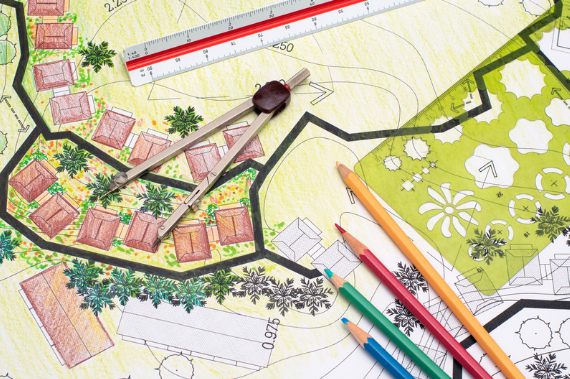Landscape architecture traditionally leans towards the more artistic side of the building design spectrum. It requires a vast knowledge of natural elements and plant life, along with the ability to ground architectural work into a building site.
This is no easy task and requires years of experience to master. As landscape designs are unique, so are the tools used to create such works of art.
That said, landscape architects utilize many different tools to complete their daily tasks. Whether you’re just starting or are a professional landscape designer, this guide will provide a good reference on what to purchase for your drafting needs.
Landscape Architect Essential Tools

What Does a Landscape Architect Do?
Landscape architects do many things. They create spectacular natural environments in parks, backyards, business premises, playgrounds, and even campuses. They also design the landscaping along roads and highways.
These professionals carefully analyze the terrain to be planted, determining the drainage, the type of soil, and existing plants. They then create designs that work harmoniously with the surrounding natural environment and man-made structures.
landscape architects are in high demand and earn an average salary of $73,160, with the top percentile netting a staggering $130k a year. Interested in becoming a landscape architect? Check out this guide on the steps to becoming a landscape designer.
Essential Tools Every Landscape Architect Needs
Now that you know what a landscape architect does, what tools do you need to get started? We’ll organize these tools into 4 categories.
- Measuring tools
- Sketching tools
- Software tools
- Planting tools
1. Measuring Tools
One of the most essential tools for landscape designers is a measuring tool. This can be a ruler, a tape measure, a compass, or a laser level. If your budget allows, you can buy a transit lever, a more expensive tripod-mounted optical tool used for measuring vertical angles.
Measuring tools are must-haves for a landscape architect, as they help determine the dimensions, angles, and elevation of a site. They also help map the location of existing features such as trees, buildings, or utilities. Depending on your project, you can use measuring tools to design accurate site plans, grading plans, or cross-sections.
2. Sketching Tools
Another important tool for a landscape architect is a sketching tool. A pen and paper can do the trick, though a digital product, like a tablet and stylus, is recommended as it’s easier to save your sketches and access them from anywhere.
Sketching allows a landscape architect to express his or her ideas, experiment with different layouts, and communicate with their clients. You can use sketching tools to create rough drafts, detailed plans, or concept drawings, depending on your needs and preferences.
3. Software Tools
Once landscape architects have a concept for a project, they must translate it into a form that others can view and understand. Most designers use computer-aided design (CAD) programs to render the design.
Software programs like AutoCAD have been the go-to for drafting construction and landscaping documents for decades. These programs are often used to create 2D and 3D drawings, models, and plans for a variety of industries, landscaping included.
Landscape architects can also use 3D modeling and rendering software, such as SketchUp, to draw a design from scratch and portray it in 3D. You could also use 3D rendering software add-ons to add realistic texts, graphics, and landscape lighting to a scene for a final presentation.
4. Planting Tools
A Planting tool is also essential for a landscape architect and could be as simple as a book or a website. As a landscape designer, you’ll need a planting tool to help you select the right plants for your design based on the plant’s suitability and clients’ requirements.
Depending on your project scope, you can use planting tools to create stunning planting plans, plant labels, or plant lists. Planting tools can also help you arrange plants harmoniously and aesthetically, using principles such as color, form, texture, and rhythm.
Wrapping Up
As you can see, a landscape architect needs a wide variety of tools to kick things off and succeed in the ever-competitive world of landscape design. We hope this guide will help prepare you for a career as a landscape architect.
Other posts you might enjoy:
Landscape Architect vs DIY; Which is Best for You?
Unlocking Brilliance: A Journey into Laser Cleaning Across Architectural Landscapes





